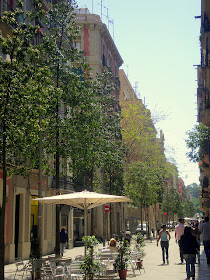 |
| Semana Santa in Leon. Photo by Jaus |
The Holy week of Castilla y León in North-West Spain that traces its history to the medieval kingdoms is characterized by seriousness, order and the artistic quality of its carvings. The silence of the public is only interrupted by the bands of trumpets and drums; the astonishing sounds fill the Gothic or Romanesque styles churches and the medieval street of every city of town of Castile and Leon. In cities like Zamora, Salamanca, Leon or Burgos were set the big procession. The passion and fervour are the common denominator of all processions in Spain, perhaps the big difference with the famous procession of Seville is that in Castile and Leon everyone is solemn instead of showing their passion like most of the South of Spain.
Also another big difference for me is the weather, when in Seville and whole Andalucia the weather is almost like spring, in Castile and Leon the last winter days are still harsh. I remember once how a good and nutritional garlic soup helps me out to go through to the most profane of the processions the Genarin burial (Thursday night) in Leon or how a big spinach and chickpea stew comfort me after seeing the slow advance of a procession under the cold shadow of a Salmanca church. But also the Holy Week is full of energetic sweet and pastries, like Buñuelos, Torrijas o aceitada served with hot chocolate.
Even though I am not catholic, the holy week (Semana Santa in Spanish) for me is a time to think and travel around Spain to discover the ancient traditions of the country.
Garlic Soup or Castile Soup Serves 4-6
You need: 150g Serrano ham (chopped) – 40g of garlic cloves (peeled and sliced) – 10 slices of stale home-made bread or free of preservatives bread from the bakery (35-40g in total will be fine) – 2200ml of your favourite stock – 50ml olive oil – 2tbsp of Spanish sweet Spanish paprika. 1 egg by serve – 1 laurel leaf.
1. Peel and slice the garlic and the bread. The bread slices between 7mm and 12mm is the ideal.
2. In a pan with some depth, start to heat the olive in a low heat with the garlic inside, stirring very often, until the garlic starts to get a slightly brown colour, avoiding any burning or your soup will be ruined. In the middle of the process add the Serrano ham. Mix very well.
 |
| Coat very well the bread with the oil and paprika |
3. Then add over 5 slices of the bread, leave for a minute or so that absorb some oil and turnover the bread. Now remove the pan from the heat and sprinkle over the 2 tbsp. of sweet Spanish paprika (if you like you can use the spicy one as well). Stir everything very well until the bread gets well coloured. Put back the pan in a very low heat for 2 minutes and then add the stock with the laurel leaf. Simmer for 20 minutes, and never allow to boil
4. After 20 minutes, season with salt and pepper and add the remaining bread, let soak in the simmering water for another 3-5 minutes, until the bread has softened. Add an extra tablespoon of olive oil.
5. Crack the eggs and introduce them in the simmering water, let them cook for 2-3 minutes or just how you like to have poached eggs.
6. Remove the laurel leaf. The traditional way of serving is piping hot in an earth bowl! But with any soup bowl will be simple delicious.
Quick Lent Stew or Chickpea Stew. Serves 4
 |
| Sometimes I like to top the stew with a chopped boiled egg |
You need: 400g canned chickpeas (washed and drain) – 500g fresh or frozen spinach (washed and roughly chopped) - 1 laurel leaf – 2 garlic cloves (peeled and sliced) – 2 white onions (chopped very finely) 1 tbsp Spanish paprika – 2 tomatoes weaving around 150g (peeled and chopped very finely) – 150g cod fillet in chunks – 1tbsp of plain flour – 1tbsp of chopped parsley
1. Heat in a pan with some depth on a medium low heat one tbsp of olive oil, then add the chopped onions and sliced garlic. Sauté 3 minutes and then add the tomatoes, and let simmer for 5 extra minutes. Add to the pan the flour, stir, then add the paprika and without stop stirring cook another extra minute.
2. Add the cod chunks and the laurel leaf cover with 1 litre of cold water or fish stock and let simmer for 15 minutes. Season
3. Add the spinach and parsley; let simmer for another 10 minutes. Finally add the canned chickpeas, simmering for another 4 minutes.
Note: Traditional in Spain they use dry chickpeas soaked overnight and then cooked in simmering water with a laurel leaf. Also traditionally they use salted cod, which as well they leave unsalted overnight for about 36 hours. In Easter they use cod, because the Holy Friday in the Catholic religion you can´t have meat like a sacrifice. On another day is also popular make the same stew, but instead of cod you are using pancetta, black pudding and chorizo; which you remove before adding the spinach and serve them like a side dish.
More: Spanish Easter Tea Time Recipes












